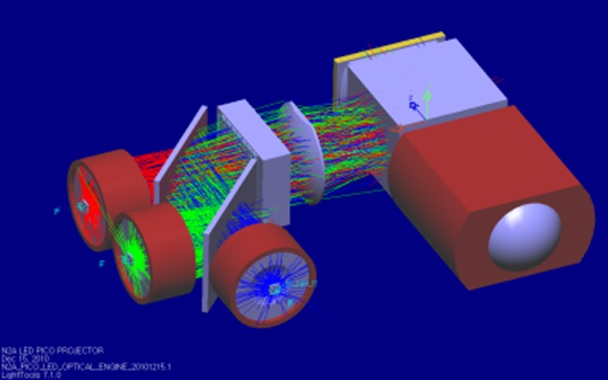June 12, 2014
Sungwoo Kim (Branch Office President)
Uniray Optics Inc.
1. Introduction
After the smart phone appeared in the middle of 2000, the number of users is increased dramatically. This shows to us that the mobile computing age started and the users expect more than communication tool from the mobile phones. Especially, various applications of smart phone are giving the chance to make new business to the developers and users. These applications also accelerate the developing of components and modules which having more advanced, convenient functions. It has been produced the virtuous circle that develop the new applications and the modules.
This article will introduce the tech trend of pico-projector which is one of the solutions that break through the display size limit of smart phone and other mobile devices.
2. Basic principle of optical systems for projector
Generally the optical system of projector can divide into three parts, light source which produce the three colors (Red, Green, Blue), illumination part(Fly eye lens, light pipe) that making the specific shape and uniform distribution of light intensity, and projection lens which project the images that coming from the panel(DLP, LCD) on the screen.
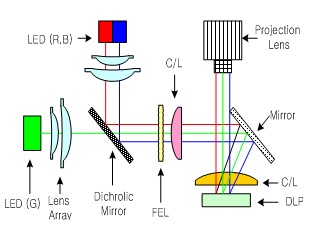
Optical system using Fly Eye Lens
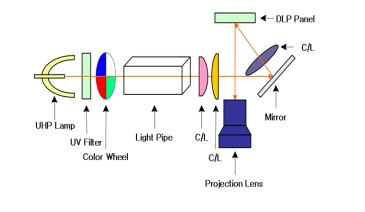
Optical system using Light Pipe
The projector systems are designed like the figures show above mostly. The systems which use the light pipe is easy to construct but it needs specific length that produce the uniform light distribution. On the contrary, the systems which use the fly eye lens do not have the space restriction but it is not easy to make it. For the small projectors, it is quite often to use the fly eye lens system for this reason. Recently, as the mold and injection technologies are progressed so the making of fly eye lenses are much easier than before and manufacturing method is changed from the glass molding to plastic injection.
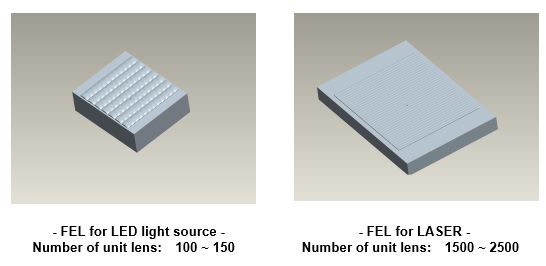
3. DLP vs LCoS
In the beginning of 2000, those companies like SONY, EPSON leaded the market with the transmission type LCD projectors. As TI(Texas Instruments) started to release the DLP(Digital Light Processing), the number of companies which produce the DLP projectors increased and this brought change of the projector market. One of the reason why this change was possible is that DLP can make possible to design the optical systems which has comparably bigger optical efficiency. For example, there is 50% loss of light in LCoS and LCD because of the polarization loss but DLP do not have this kind of loss because it is using the optical property of reflection with the micro mirror array. By this reason, those companies like Optoma, Samsung Electronics and LG Electronics etc. using DLP on their products despite of TI's high cost and mass order policy. For the pico-projectors, it is necessary to apply the DLP because the light efficiency is very important. Small companies produce the projectors which using LCoS for the reason of its supplying companies support the solutions which can make the high resolution with low cost.

4. LED vs Laser
The halogen lamp had been used as the light source for projectors but it is mostly substitute to LED now. Especially, for the small size of projectors like pico-projectors are using LED. In 2009, those companies which produce the pico-projector was Samsung electronics, Optoma, APTEK and so on, but in 2010 more than 30 companies in China and Taiwan started to produce pico-projectors. Premium products in Big companies are using DLP, on the other hand, local companies in China and some small companies in Taiwan use LCoS for pico-projectors in cheap price. The remarkable embedded case of pico-projector is the mobile phone, especially smart phone. One of the most popular product is Haptic Beam (Samsung Electronics) and it use the projector module from the young optics in Taiwan but it did not appeal to the customers from the low brightness.

In the system that using the Lasers for light source, it has the issue on the Green light that needs a wavelength conversion element (DPM) so it gives us the difficulty to line up the optic axis and low efficiency. There are some companies (Nichia, Kai and Osram, etc.) which produce the green Laser Diodes that directly emit the green wavelength of light, still have the issue of low light intensity. The laser projectors produced since 2009 and its major company is Microvision which introduced the projector with scanning mirror and it has still technical issues of speckles and the limitation of emission intensity (should not exceed 15lumen) because of the eye safety. The AAXA is another company which produce the laser projector that does not use the scanning mirrors and solve the speckle problem, and Light Blue Optic also produced laser projector which using the holographic optical element. Recently the technology which eliminates the speckle is supplied by various companies like 'Dyoptica' and the development of increase of resolution by improvement of scanning mirror driving is in progress.
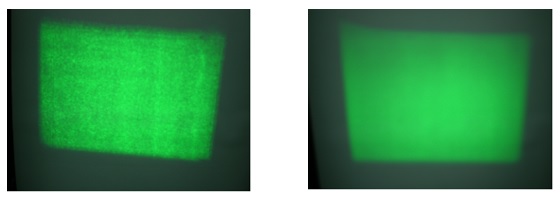
Speckle and Image quality improvement by vibrating mirrors
5. Design of the optical engine for pico-projector
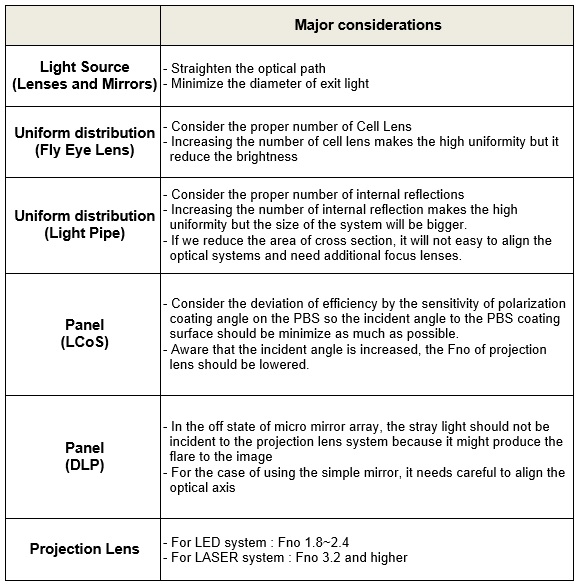
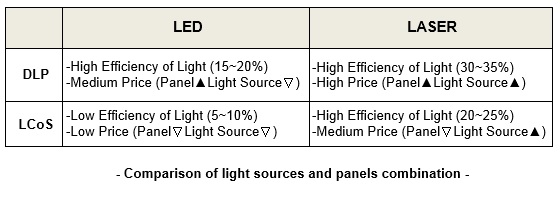
6. Conclusion
It has been many years passed since the pico-projector was introduced but the market still stay in the initial state. Several major companies like Samsung electronics, Optoma are leading the market with the pico-projectors which using the LED and DLP. Some companies release the products which using the LED and LCoS to approach the market with low price and this dividing the market into two groups of premium and popular. The high optical efficiency pico-projector which using LCoS and Laser developments are in progress, but for the time being the pico-projectors using LED light source with DLP/LCoS will lead the market. It will be expected that the laser pico-projector challenge the position of LED-DLP/LCoS product when the price of laser down and make the perfect solution for the speckle issue.

